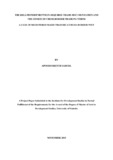| dc.description.abstract | The regional integration and development of world nations can only be meaningful if
accompanied by the modernization of their border crossing points. There is the ever
growing desire to put in place a border system capable of facilitating the mobility of
persons and goods while at the same time secure enough to control the negative effects
attached to such movements. However, the ‘traditional’ two stops border posts in Africa
have remained impediments to cross border mobility by diminishing business and
movement of people. This study therefore sought to fill the gap by conducting a
comparative assessment on the effectiveness of one stop border post in facilitating cross
border mobility in East African Community. The research was guided by three main
theories namely; territorialism theory, coordination theory and Deutsch’s cooperation
theory. The researcher employed descriptive survey research design. The study was carried
out in Busia and Oloitokitok border control points. The choice of Busia was informed by
the fact that it is one of the busiest OSBPs in the region. Oloitokitok on the other hand was
selected to represent a two-stops border post. It was not easy to determine the target
population for the study as it targeted all the travelers and traders whose population was
unknown. It also targeted government officers on duty at the said borders. The researcher
therefore resolved to administer questionnaires to fourteen (14) travelers and fourteen (14)
traders studied at different intervals at both Busia and Oloitokitok border stations.
Convenient sampling technique was used to get the travelers and traders. In addition, the
research focused on forty (40) government duty officers within the two border stations and
applied simple random sampling technique. Thus, the research identified five (5)
departments namely; Kenya Revenue Authority, Directorate of Immigration Services
(DIS), Police, Kenya bureau of standards (KEBS) and Port Health from which eight (8)
respondents were picked for the study totaling to forty (40) government duty officers. The
main sources of data for this study were questionnaires, interviews and observations.
Qualitative data was analyzed and interpreted using content analysis. On the other hand,
quantitative data was analyzed and interpreted descriptively and the results were presented
through charts, graphs, frequency tables and percentages. The findings revealed that the
implementation of one stop border post facilitates cross border mobility within East Africa
Community. It was established that cross border mobility in East African Community is
mostly affected by legal framework and border procedures. However, infrastructure and
equipment was found not to affect cross-border mobility significantly. The research
recommended that the governments involved should establish OSBP in all their borders
and harmonize legal frameworks and border procedures if cross-border mobility is to be
enhanced. | en_US |



